Progress is being reported in the effort to save the USS The Sullivans after it sank at its pier at the Buffalo and Erie County Naval and Military Park in Buffalo, New York earlier this month.
The U.S. Coast Guard and officials at the back are reporting that the historic destroyer has been partially refloated, with only its bow on the lakebed, and the list reduced to less than 4 degrees.
The decorated U.S. Navy destroyer-turned museum ship partially sank at its pier on April 13 after a “serious hull breach” on its starboard side. Officials have since been working to dewater the ship in an effort to refloat it.
Built in 1943, USS The Sullivans is one of only four Fletcher-class destroyers remaining in existence. The class are known for being the largest and most important class of U.S. destroyers used in World War II. USS The Sullivans is also the first ship in the U.S. Navy to be named for more than one person—named after the five brothers from Waterloo, Iowa who were killed in action in 1942 while serving together on board the USS Juneau.
The USS The Sullivans is owned and maintained as a museum ship by Buffalo and Erie County Naval & Military Park, the largest inland Naval Park in the United States.
“The dewatering process of USS The Sullivans DD-537 began in earnest this morning and has already shown incredible results,” the park said in an update on its Facebook page. “The ship is now at a current list of less than 4 degrees and we are optimistic that it will be re-floated and righted in the near future. We’re not out of the woods yet but this is a major step towards getting there.”
“Today we can all breathe a bit easier as progress on The Sullivans continues with amazing results,” U.S. Coast Guard Sector Buffalo said in an update. “The Sullivans has been partially refloated and with continued dewatering operations, we can see the ship fully upright soon… We say partial because the bow is still resting on the lakebed, which is favorable for support and stability.






